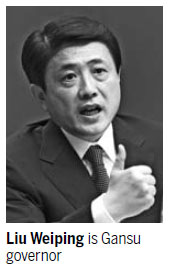Lanzhou New Area launched
Updated: 2012-09-08 08:21
By Zhao Yinan in Beijing and Xue Chaohua in Lanzhou (China Daily)
|
||||||||

China has mapped out a new State-level development zone in the inland Gansu province, as the country eyes its western regions amid a general slowdown in coastal areas.
The Lanzhou New Area is expected to promote bilateral trade with Central and Western Asian countries, officials said.
The area - which is about 30-minute drive from Lanzhou, Gansu's capital - has been sectioned out by the central government in August as the fifth national-level development zone, after similar zones were set up in metropolises such as Shanghai, Tianjin and Chongqing.
The area is also the country's first national level economic zone in a northwestern province. Underdeveloped western areas are expected to catch up with coastal cities, where enterprises are now feeling the pinch from shrinking trade and rising labor costs.
The district, which sits in China's geographical center, also sees its strategic significance underlined in tying together ethnically concentrated zones, including the Xinjiang Uygur and Inner Mongolia autonomous regions, as well as Qinghai and Sichuan provinces.
"The establishment of the Lanzhou New Area marks the country's latest effort to accelerate development of the western regions," Qin Yucai, director of the National Development and Reform Commission's Western Development Department, the country's top economic planning agency, said at a news conference in Beijing on Friday.
"The area will serve as a pilot zone for the nation's economic restructuring efforts and as a strategic platform for opening up the western regions," he said.
He noted the area is also important to maintain national unity and for its ecological conservation projects.
Liu Weiping, governor of Gansu, believes that the area will offer opportunities to companies, such as energy smelters and automakers, both at home and abroad.
The province's traditional economic advantages also include nonferrous metal smelting, such as aluminum alloy and carbon, which are widely used in large aircraft manufacturing.
To attract more investors, central and provincial governments have invested heavily in the area's infrastructure projects.
Liu pledged to extend its role as a logistics center linking Central Asia and Western Asia by building more railways and highways in the province, which has already seen at least three arterial railway lines joined at the country's largest railway hub in the west.
The province plans to start building a railway line and an expressway before the end of the year to link Lanzhou's old city with the new area, he said.
"Total infrastructure spending has reached 24.6 billion yuan ($3.9 billion) so far," he said, vowing to adopt favorable financial and tax policies to attract more companies.
Covering 806 square kilometers and with a population of about 110,000, the area has already attracted 90 investment projects, with a total volume of 70.7 billion yuan.
Some of the country's top 500 companies, including Geely Automobile and Sany Heavy Industries, have already set up plants or have factories under construction there.
Liu said the area's GDP is to reach 50 billion yuan by 2015 and 270 billion yuan by 2030, and its population is likely to exceed 500,000 by 2020.
The four other State-level new areas are Shanghai's Pudong New Area, Tianjin's Binhai New Area, Chongqing's Liangjiang New Area and the Zhoushan Islands New Area in Zhejiang province.

 Relief reaches isolated village
Relief reaches isolated village
 Rainfall poses new threats to quake-hit region
Rainfall poses new threats to quake-hit region
 Funerals begin for Boston bombing victims
Funerals begin for Boston bombing victims
 Quake takeaway from China's Air Force
Quake takeaway from China's Air Force
 Obama celebrates young inventors at science fair
Obama celebrates young inventors at science fair
 Earth Day marked around the world
Earth Day marked around the world
 Volunteer team helping students find sense of normalcy
Volunteer team helping students find sense of normalcy
 Ethnic groups quick to join rescue efforts
Ethnic groups quick to join rescue efforts
Most Viewed
Editor's Picks

|

|

|

|

|

|
Today's Top News
Health new priority for quake zone
Xi meets US top military officer
Japan's boats driven out of Diaoyu
China mulls online shopping legislation
Bird flu death toll rises to 22
Putin appoints new ambassador to China
Japanese ships blocked from Diaoyu Islands
Inspired by Guan, more Chinese pick up golf
US Weekly

|

|






